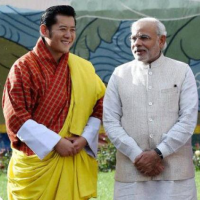It’s India-Bhutan Bhai-Bhai on Modi’s First Foreign Visit
 Bhutan's King Jigme Khesar Namgyel Wangchuck with Prime Minister Narendra Modi
Bhutan's King Jigme Khesar Namgyel Wangchuck with Prime Minister Narendra Modi
A speech in Bhutan’s parliament, a grand reception by the King and Queen, and a state banquet hosted by Bhutanese Prime Minister Tshering Tobgay – Prime Minister Narendra Modi received a red carpet welcome in Thimphu on his first foreign visit after taking office.
This comes as no surprise – both countries enjoy a special relationship going back decades, since independent India’s first Prime Minister Jawaharlal Nehru arrived by yak in 1954. There were no roads in Bhutan then – its first road was built only in 1962 – but fast-forward to 2014 and there is strong cooperation between both countries.
If there was any surprise it was over Modi’s choice of Bhutan as his first official destination, partly because the Himalayan kingdom is considered a small player in South Asian affairs. Bhutan’s government seemed almost as surprised as anyone else, but quickly rose to the occasion, mindful of the importance that Modi had accorded bilateral ties.
The new Indian Prime Minister has proved adept at changing the stodgy status-quo that characterised the policy-paralysis of the previous Congress government.
Modi’s decision, for instance, to invite the heads of all of India’s South Asian neighbours, including Pakistan, to attend his swearing-in ceremony in New Delhi in May, was a masterstroke that rejuvenated India’s regional ties and made it clear that his administration would be pragmatic in dealing with its neighbours.
According to Sanjeev Miglani of Reuters, Modi’s team aims to make India a key regional investor and the main provider of infrastructure loans in its immediate neighbourhood, in much the same way that China has done in Central Asia and Africa.
Nevertheless, the bilateral ties between India and Bhutan almost never appear in the international spotlight, yet these deserve to be. Here are two countries almost completely different in every way: India has a population of 1.2 billion, Bhutan has a mere 750,000; India is a complex and diverse multi-religious society, Bhutan remains strongly Buddhist; India has a vibrant often chaotic democracy, Bhutan became a constitutional monarchy in 2008 only because it’s previous king forced his own people to accept democracy.
Yet these two neighbours – the Goliath and David of South Asia – are strong allies. India provides 9 billion rupees ($150 million) in financial assistance for Bhutan’s development and Bhutan generates hydroelectric power – expected to reach 10,000 megawatts by 2017-2018 – for its energy-hungry neighbour.
"The relationship between India and Bhutan is historic. The new government is committed to make this even stronger," Modi announced in his speech to Bhutan’s parliament on Monday.
Bhutan also plays an important strategic role as a buffer between India and it’s northern neighbour China with which India has a long-running boundary dispute.
China’s recent overtures to Bhutan have not gone unnoticed in New Delhi, particularly Beijing’s offer to resolve its own contentious 400-km long border with Bhutan in exchange for Bhutan finally allowing diplomatic relations with China.
The China factor probably explains why India’s National Security Advisor Ajit Doval has accompanied the Prime Minister to Bhutan.
It may also have prompted Modi to choose Bhutan as his first port of call. But by reinforcing the strong ties between their two countries, he may have single-handedly swung Bhutan’s focus back India’s way.
- Karan Singh
- Top Stories
- Controversies
- Where is the Money Going?
- India and the World
- Appointments and Resignations
- Unusual News
- Latest News
- India College Chain’s Expansion into U.S. Draws Opposition from Massachusetts Officials over Quality of Education
- Milk Shortages in India Tied to Release of New Movies Featuring Nation’s Favorite Stars
- Confusion Swirls around Kashmir Newspaper Ban in Wake of Violent Street Protests
- Polio-Free for 5 Years, India Launches Vaccine Drive after Polio Strain Discovery
- New Aviation Policy Could Increase Service, Lower Ticket Prices






Comments